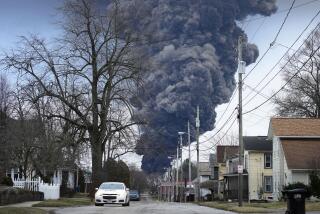Carbide’s Sabotage Theory at Bhopal Angers Indians
BHOPAL, India — As a critical decision approaches in a federal court in New York on whether billions of dollars in legal claims against the Union Carbide Corp. should be tried in the United States or India, the company’s senior executives have taken the position that sabotage may have been the cause of the poison gas disaster in Bhopal that killed more than 2,000 people.
“All the evidence points to a deliberate act by a person on the scene as the only plausible explanation for what happened,” Union Carbide Chairman Warren M. Anderson said in a statement to employees last week.
“We have all but ruled out anything but a deliberate act,” Jackson Browning, the company’s vice president for health, safety and environment, said at a November symposium in London.
Union Carbide officials have never suggested who might have had a motive for such an act.
Indian government officials and investigators have reacted angrily to the sabotage theories, which were first made by the company in a legal filing before a Madhya Pradesh state government inquiry last spring and have since been stepped up.
Union Carbide’s sabotage theory is based on the assumption that there would have to have been between 120 and 240 gallons of water inside a storage tank of liquid methyl isocyanate at its pesticide plant in Bhopal to produce the kind of chemical reaction that sent almost 40 tons of deadly poisonous gas into surrounding slum communities on Dec. 3, 1984.
The only way that such a large amount of water could have got into the sealed tank, executives say, is for someone to have intentionally put it there.
Indian scientists who have examined the plant and conducted tests on the interior of the stainless steel tank where the methyl isocyanate was stored contend that a chemical reaction could occur without such large amounts of water.
Before the gas leak, Indian investigators say, several workers used water from a hose to clean pipes in the vicinity of the tank. One hose may have been left running for a period of several hours, plenty of time for water to enter the tank in quantities necessary to cause a reaction.
“Union Carbide does not even know its own chemistry,” said Dr. Srinivas Varadarajan, director general of the Indian Council of Scientific and Industrial Research. “I said that a little water and a millionth of a gram of iron would cause a reaction.”
Varadarajan, 57, India’s chief scientist, holds doctorates in chemistry from both Delhi University and Britain’s Cambridge University. He headed a team of scientists who investigated the accident and supervised removal of more than 30 tons of the methyl isocyanate, commonly known as MIC, from another storage tank.
Lack of Information Charged
“I don’t think there was any chance of sabotage,” Varadarajan continued. He said that Union Carbide safety manuals retrieved from the plant did not mention the danger of water reacting with stored methyl isocyanate.
“Why would you not inform your workers that, for heaven’s sake, don’t get any water in it?” Varadarajan asked rhetorically. “Why would a saboteur know any more than your own employees, your own engineers?”
The government of India, in constructing a case against Union Carbide, hopes to prove that the company took “major design shortcuts” in building the plant, leaving out critical safety features contained in its other main MIC facility in Institute, W. Va., according to sources close to the Indian investigation.
On Thursday, government attorneys for Madhya Pradesh, of which Bhopal is the capital, filed a statement before a state commission of inquiry totally blaming Union Carbide for the disaster.
Charges in the 15-page statement, the first response to the Union Carbide filing before the same commission suggesting sabotage as a possible cause, included a claim that the company stored “dangerously large quantities” of the deadly gas at Bhopal.
It alleged further that the American company ignored its own safety reports, that the tanks containing the chemical were not sufficiently insulated and that various other safety systems were turned off or were not functioning at the time of the accident.
On Friday, the state asked that Anderson, the Union Carbide chairman, appear before the commission. State officials also said they plan to continue criminal charges against Anderson and two senior Indian executives for “culpable homicide not amounting to murder.”
These charges against Anderson, Union Carbide of India Chairman Keshub Mahindra and Managing Director V.P. Gokhale carry the possibility of life sentences.
Anderson was arrested in Bhopal four days after the accident, when he came to inspect the plant and offer relief to victims. He was released a few hours later and was permitted to leave the country. Although all three men have been arraigned and were required to post bond, the investigation is continuing and final charges have not been framed.
The sabotage charges by U.S. executives of the Danbury, Conn.-based coproration come at a critical time in the litigation against the company.
In January, U.S. District Judge John F. Keenan in New York will hear oral arguments on a Union Carbide motion to dismiss the 114 cases consolidated in his court on grounds that Indian tribunals, where at least 3,980 lawsuits have been filed against the company, are the only proper forum for claims by Indian victims.
Several lawyers contend that Union Carbide, by taking an aggressive posture at this time, is hoping to prompt an out-of-court settlement with the government of India, which represents all the Bhopal victims. A Union Carbide settlement offer of $300 million has already been rejected by the New Delhi government.
The company’s position has lowered the American company’s already rock-bottom image in India. Union Carbide India Chairman Mahindra complained at a recent stockholders’ meeting of being “charged and vilified” as being one of “the biggest criminals in corporate history.”
The few Union Carbide executives remaining in Bhopal find it difficult to support the sabotage theory propounded by American executives.
The company’s Bhopal research director, Sivasankaran Srivastava, put it this way: “Look, both sides have to say what they are saying. The Indian government has to say what it is saying because they want to show a design defect is there. Carbide has to say what it is saying because it wants to show the design was perfect.”
The two sides’ postures aside, the death count at Bhopal is staggering: More than 2,000 people, 790 water buffalo, 270 cows, 483 goats, 90 dogs and 23 horses. About 320,000 people in Bhopal, with a population of 900,000, were affected by the gas.
Other Alleged Shortcomings
According to Indian scientists and investigators, most of the deaths were due to failures in the plant’s safety system. Among other alleged safety failures:
--A 30-ton refrigeration system installed at the plant to cool the methyl isocyanate was not operating.
--A flare tower used to burn away escaping gases had been dismantled for repair and was not working.
--An empty storage tank kept for emergency transfer of MIC was not used in the panic that followed the initial leakage.
--A “scrubber” designed to neutralize MIC gas with caustic soda was not large enough to handle the volume of escaping gas.
In addition, both workers and residents of adjacent communities were not adequately informed about the dangers of the MIC gas and the precautions to take if they were exposed to it. According to Varadarajan, most of the deaths and injuries could have been averted if people had been told to spread wet handkerchiefs across their faces.
Rone Tempest reported from Bhopal and Michael A. Hiltzik from New York.
More to Read
Sign up for Essential California
The most important California stories and recommendations in your inbox every morning.
You may occasionally receive promotional content from the Los Angeles Times.










